Way back in the 50s and as Lex would say, “when I was a wee nubbit”, we had a Beagle named Sam. And like most Beagles, he loved to roam whenever the chance presented itself, such as a front door not closed fast enough. When that happened, the task to retrieve him fell upon me. I would chase him down the street of our Studio City neighborhood and at that young age learned there was only one thing that he liked even more than roaming – food.
Only I didn’t bring food so I did the next best thing – held a finger in such a way that, together with my coaxing him, would eventually bring him to me. Even 60 years later I can still see that dog looking at me from a distance, trying to decide whether this was yet another ruse or was he serious this time?
Even at 7 years old I could see those gears turning.
It took some coaxing with the dog staring at me 100 yards away but eventually curiosity would get the best of him. And then when I grabbed his collar, if a dog could register a “disgusted” look….
Most of the time I caught him but the Los Angeles Animal control eventually caught him 2 times. If the count came to 3, it was a $50 fine, a not insignificant sum in the 1950s.
So my parents told me one day that they “gave him to a farmer”.
Which I believed for 40 years, until my mother finally admitted that they took him to the pound. If I had had a moment’s reflection, I would wonder how many farmers there were in Los Angeles, but children want to believe.
In any event my mother told me that at the time since the Beagle was one of the most popular breeds (in the 50s) the people at the pound told her someone would want him right away.
Where the cycle would undoubtedly be repeated.
I have always had a bit of a Beagle in me whenever the opportunity presents itself. With a few exceptions, I don’t venture out with a specific “hard-coded” itinerary. I do have a few things on my mind to see, but as my old Army drill sgt would say while banging on a trash can in the barracks at oh-dark-thirty, “Everything’s subject to change”. I have always started with a few goals, which can change, but it is the wind that eventually takes me to various places.
This trip I wanted to see things such as the Ford Museum in Dearborn, MI, Niagara Falls, a drive down the coast along Nova Scotia, New England and Appomattox, VA. Thought I’d get to see New England in the fall. Along the way, with the realization that the Post Office would hold my mail for only a month, I had to make some modifications while on the road. For example, had I gone to Niagara Falls (still on my bucket list), I would have to drive 1100 miles north just to get to Halifax, Nova Scotia. And then take a few days driving along the coast. And return. And I had my passport ready.
I made the same mistake many Europeans make when they think they will see Yosemite, then drive to Las Vegas that evening.
There are hopefully more opportunities for me “down the road”.
I’ve also had a curiosity for some years to see the room where Robert E Lee surrendered his Army of Northern Virginia to Ulysses S Grant.
By the way, as an aside, didja know that Ulysses S Grant wasn’t his real name? When he enrolled at West Point, the Army mistakenly registered him under that name, and would not correct it. “If the Army wanted you to……”
In 1839 Grant was appointed to West Point, where he registered as Ulysses Hiram Grant, transposing his given names because he did not want to be known by the initials H.U.G. Due to a mistake by a benefactor on his application form to West Point, Grant was listed as “Ulysses Simpson Grant” (Simpson being his mother’s maiden name). His nickname at West Point was “Uncle Sam.”
But like an earlier drive in 2006, the primary purpose of this drive was another family obligation. I was to bury my mother’s ashes in the family cemetery in West Virginia. She died a few years ago at age 97. The purpose of that earlier drive was to attend a wedding of my niece in Minnesota and while my family was getting plane reservations, I saw the front door open. My mother told me, “Bill, I’m not going to say anything more but…[A familiar preamble!]…I think you are a damned fool for taking that old car back there!” I knew then as I know now, it was a mother’s worry. But that door was open!
I felt confident in the car, a 1986 Mercedes-Benz 300E, because I maintained it and knew when every critical component had been replaced. The car turned 300,000 miles outside Rawlins WY and guess what the family depended on to ferry them to various functions around Minneapolis?
So this time the mission was to bury my mother alongside her family in West Virginia. While there, the thought came to me that this was the first time she was back with her parents, 2 brothers and a sister in 83 years (her father died November, 1941). I imagined 6 smiling faces behind the veil on that beautiful fall day.
Sometimes, when bad things happen in our lives, good can come from other unexpected areas. After my father died, my mother came to depend on me for such things as taking her to doctor’s appointments. I would visit her every evening and have dinner with her and her friends at the extended care facility.
We would talk not as mother and son, but friends. She told me as a small girl her father would put her on her shoulders and walk the 5 miles up the road to what was the family farm. While trying to carry her, he called her “monkey girl.” I was picturing a little girl, squealing with laughter, and trying to crawl all over her father as he made that long walk.
The bridge over the main C & O railroad lines hadn’t been built, which meant that her father left the car behind the tracks for the long walk. They lived downtown but at the time her uncle lived on the farm. It was a place I called my second home during my formative years.
And now she was back with her father overlooking that road from the hill.
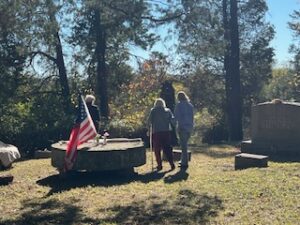
The following stops were done in chronological order. And a couple of “honorable mentions” are listed at the end.
The Greenbrier Bunker
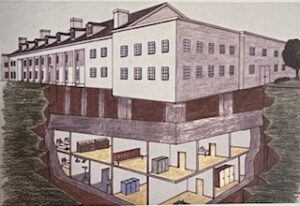
After West Virginia, I wanted to see something that held my curiosity for years. It was top secret; so much so that even members of Congress were not aware of its existence. I used to drive by it every time on Rt 60 from Charlottesville, VA to and from Huntington. I wanted to recreate this drive instead of taking the faster I-64. For the most part I did pass familiar places like Hawks Nest, although the route forced me to take I-64 in places. I was not able to drive through the familiar eastern Virginia towns like Covington and Clifton Forge.
The bunker was started by President Eisenhower in 1956 at, of all places, the resort hotel of the Greenbrier at White Sulphur Springs, West Virginia. Built during the Cold War and finished in 1962, it was designed to house members of Congress and their staff in the event of a nuclear war. I was told that the closest it came to being used was the 1962 Cuban Missile Crisis. Secrecy was maintained during its construction because at the same time a regular hotel annex was built on top of it. Even most employees of the Greenbrier were not aware of its existence.
If “the balloon went up”, as we used to say in the Army, only the House and Senate majority and minority leaders were aware of its existence and procedures. Amazing that they could keep a secret, considering Congress these days.
They would then tell their respective members of Congress to be at Union Station in 30 or 60 minutes (I forget the time interval) where a train would take them to the train station directly across the street from the Greenbrier. Families were to be left in Washington DC.
There they would be led through a secret tunnel where they would each be hosed to decontaminate them from radiation – with their clothes on (they would later be burned and they were given govt issued clothing). I got a silent chuckle thinking of some of these politicians with inflated egos being hosed down like a dog who had been rolling in the manure.
There were living quarters with bunk beds – 60 to a room, with the names of each Congressman or Senator on the bed. Their prescription needs were taken care of, with a monthly run to Walter Reed Hospital in DC to update each individual prescription.
With each election cycle the names would be updated with new prescription needs.
I think the most amazing room was a huge area the Greenbrier used for trade shows with a huge vault door hidden by a false wall. People were using part of the bunker for years and unaware of its existence!
The bunker was not designed to protect against a nuclear blast but radiation only.
Perplexing to me was the fact that we could not take cameras or cell phones. Particularly since it was declassified. It was declassified in 1992 when a Washington Post reporter wrote about it. They urged me to leave mine in the car (I did) but they also had a locker for those who didn’t get the message. The answer came when we learned that many major corporations use the facility to house massive computer servers – whether it is for back up (their “cloud”) or day to day use I forget. But they were worried that a cell phone could carry a virus that would get to the computers. (how it would do this I have no idea). However, after the tour they gave us each 6 post cards.
University of Virginia and Charlottesville
After The Greenbrier, it was off to Charlottesville and my alma mater, the University of Virginia. As mentioned, I was taking the slower (but more scenic) Rt 60. I-64 hadn’t been finished and as I recall I would make the trek from Charlottesville on Hwy 250 to Waynesboro VA, then I-81 to Blacksburg, then catch Rt 60 through the Shenandoah Mountains via some Virginia towns like Covington and Clifton Forge – passing the Greenbrier, all the way to Charleston, WV and I-64.
For some reason I seem to remember passing the Virginia resort hotel The Homestead at Hot Springs. I do remember taking my skis back from California and actually skiing on the Homestead’s mountain one time– but whole snowpack was like ice – which made for an interesting time. It was like coming down a steep ice rink on greased bananas. In any event this time I did not pass The Homestead.
Before Charlottesville, I stopped at Lexington along I-81 at Washington and Lee University (Robert E Lee became head of the school after the War and I had heard that he never wanted to talk about the War afterwards). I wanted to see his tomb in the chapel but like so many of my stops across the country it was closed that day. I did see it while a student 52 years ago.
At UVA, there were changes I noted in the subsequent years, some good and some perplexing.
On the good side, there were co-eds. Lots of them. At the time, other than the nursing school, female students went to Mary Washington. UVA students would go to Hollins, Sweet Briar or Mary Washington to meet women. (Some UVA slang at the time: “Let’s roll to Hollins!”. On the perplexing side, I had a moment of, if not sheer panic, confusion.
I went through a door clearly marked as “Men” only to see a …… tampon machine. Here’s where the mild panic set in – picturing some surprised females exiting their stalls. Call me old fashioned but there are few places left for either sex where one can expect their privacy. I don’t know of many women who want to use the men’s restroom and vice-versa.
I turned around and there was “the comforting sight” of the urinals, with not a female in sight.
What was that all about? Did I miss something in the 6th grade sex ed class? Are men now having their periods in this brave new world? Inquiring minds need to know.
But “The Lawn” – the original university as designed by Thomas Jefferson with the classrooms and living quarters on each side facing the Rotunda, was as I remembered it. The Rotunda was remodeled inside. The Corner was as I remembered it, and I had to have a lunch at The Virginian for old time’s sake.
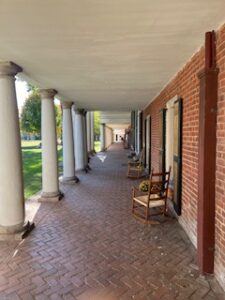
I was dismayed to learn some time ago that the students at UVA had decided to water down the honor code. At the time there was only 1 penalty upon being found guilty of an honor code violation – expulsion. I have told people in recent years that it was obvious from my grades that I had adhered to the honor code – and in one little general store on Rt 60 between Clifton Forge and Covington with a Virginia state trooper and store owner-magistrate as witnesses, it kept me out of jail.
After 54 years I can still remember the pledge we had to write on the front page for each exam in our “blue books”:
On my honor as a student I have neither given nor received aid on this exam.
(signed)
Any infraction with another student as a witness went before a student court and would mean innocence or expulsion, the only 2 possible outcomes. It seemed that every year 1 or 2 would be expelled.
When I was at UVA, I was one of 12 Californians – including the law school – out of 8,000 students. Students from the West Coast were a bit of a curiosity, although there were many from the South, Texas and Northeast. Had one roommate from North Carolina where I learned its correct enunciation: “Nawth Calina”! And I had another roommate from New Hampshire. It seems even more “cosmopolitan” now.
As far as celebrities went, I remember some graffito in a stall at the Law Library (while studying for an International Law Class) written by a rather bored student “attending to business” .
“Just think, one bored student wrote inside on the door, “Teddy Kennedy sat here!”
My first year, I roomed with 3 other students at the home of a widow – Mrs Pegaux – off Rugby Rd but for the life of me could not remember the street this time. If you looked at my above linked “Speeding in Virginia” post, my Camaro is at her house under the snow.
Anyway, at my 20th Reunion in 1992 (where, since I was “so close” to Europe, I decided to fly on to Germany from Dulles), I told a then-student that “The longer I have been out the smarter people think I am”. Meaning the entrance requirements have gotten even tougher.
Had to take a drive “up the hill” to see Thomas Jefferson’s residence, Montecello, and a lot had changed. Not his residence, of course, but a new “Welcoming Center” with tours of the exterior (new) along with the home. I’d never been on an exterior tour and since the interior tour was at least an hour away, did a walk around the grounds. I remember driving up the hill and past his grave. As you can see from his headstone, creating “his University” was one of his 3 proud achievements. He’s been known as “Mr Jefferson” at the school ever since.
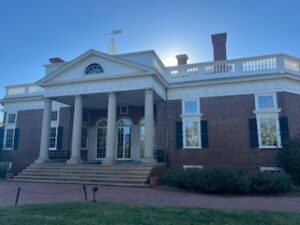
But now even the road had been changed to allow the “welcoming center”.
When I was a student 54 years ago Charlottesville was a large town. Now it is a small city. Along with Middleburg, it is a home to a few billionaires.
I stand to be corrected, but it seems to me that in 1970 my tuition at UVA was about $850 per semester – and that was the out of state rate.
From Charlottesville, it was on to Appomattox, only 60 miles away. I’d had a curiosity to visit this for years – and thanks to Mr. Garmin he took some beautiful local roads in the Virginia countryside. The trees were starting to change with sights we don’t get in California.
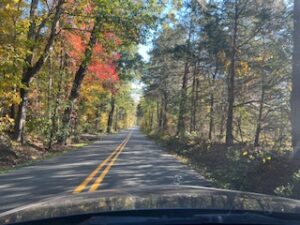
Virginia is a bit like Illinois (or Georgia) in that there is one big metropolitan area (the DC area) and the then there is rest of the state. And in the rest of the state, there is a lot of beautiful variety. Other than the lack of deserts, it reminded me of California. Virginia Beach reminded me of San Diego, with the ocean on the other side of the street. I travelled on small local roads with beautiful fall colors, passing small farms and 1 laned bridges and oncoming traffic with drivers who’d wave back to me.
It is a world apart from the DC area. There’s Virginia and there’s the DC metro area. Maybe I’ll include old town Alexandria (one of America’s oldest cities I believe) in the “Virginia” Camp.
A Visit To the Appomattox Battlefield and Surrender Site
If you ask the average American what was the costliest war, most will say WW2. That isn’t even close. It was our Civil War, with over 600,000 killed. And that was with a population less than 10% of today. For perspective picture that number as over 6,000,000 killed today.
Appomattox was on my “bucket list” for several years. It was the location of the second meeting between Robert E. Lee and Ulysses S. Grant, the first being Mexico City during the 1846 Mexican-American war. Grant would ask Lee if he remembered that meeting but Lee replied that he didn’t. So many Civil War generals on both sides had West Point and the Mexican-American war as training grounds.
One of the first things I did was take a small ¼ mile hike to see a monument erected by North Carolina for her soldiers. It was in the middle of a forest all by itself. What I learned subsequently at all the major battlefield sites that I visited, was that towards the end of the 19th century and early 20th century veterans from both sides would return and tell park officials where they fought. At Gettysburg and Vicksburg I heard there are over 1,300 monuments. I don’t know how many Antietam has.
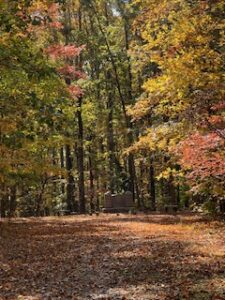
I envisioned the McLean house (where Lee and Grant met in the living room), to be in the middle of the modern town. As I discovered, the NPS had the house in an area (its original location) with the Clover Hill Tavern having printing presses that hurriedly printed 30,000 Parole Passes for all the soldiers of the Army of Northern Virginia to return home in peace – including free train travel and Federal rations. They agreed to lay down their arms and swear allegiance to the US.
They recreated Appomattox “as it was” down the road from the modern town. I suspect the original buildings remained due to their historical importance.
Because Lee’s surrender only included the Army of Northern Virginia, many of the men paroled at Appomattox Court House had to pass through active war zones to return to their homes. To ensure that Lee’s men were not mistaken for deserters or active combatants by other Confederate and Federal forces, Grant agreed to print parole passes that would allow each man to navigate safely through areas where the armies remained active. These passes allowed the paroled Confederates to secure free passage on board Federal trains and steamships, and they also permitted Lee’s men to draw rations from any Federal forces they encountered on the way home. On April 10, Federal soldiers set up printing presses in the Clover Hill Tavern and General George Sharpe oversaw the printing of approximately 30,000 passes in the span of about 30 hours. Once printed, the passes were distributed to Confederate officers who filled them out for the men they commanded.
There is a nice write up detailing the battle and the events that led to Lee’s surrender here. And a description of the first meeting here.
Here is a sample of a Parole Pass for one Confederate officer, and here is an original pass. .
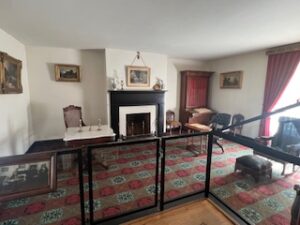
What surprised me in writing this post was that the NPS actually created a .pdf file of the names of all the parolees – and many of the soldiers in the Army of Northern Virginia were from all over the South – even a Rudolf Brandt from South Carolina!
I had heard that General Sheridan stole all the McLean’s furniture. I learned there it was not true, but he needed a desk and took one of the 2 that Lee and Grant used. Other Union officers took pieces of the furniture as souvenirs.
The funniest thing about that was who the Union officers called “the silent witness”. In cleaning up the house and living room for this occasion, the McLeans forgot the little doll 7-year-old Lulu McLean left on the sofa. A Union officer took this doll as a souvenir where it stayed in the family for 126 years (until 1991) – until they gave it back to the NPS for their museum where it resides today.

From what I read; General Grant was very cordial to General Lee. When the Federal Army started to fire cannons in celebration, Grant ordered it stopped out of respect for Lee and his Army. I could only imagine the despair and sadness of Lee’s soldiers, who saw so many comrades die and suffered with so many deprivations, to be here now. I read that during the surrender, Lee told Grant that his men hadn’t eaten in 2 or 3 days. Grant’s Army captured the Confederate train bringing them provisions, which was one of the factors leading to the meeting. Lee was told that his men would be fed.
Lee arrived in his best attire thinking he would be taken prisoner and Grant treated him and his Army with respect and cordiality. When they parted each tipped their hat to the other out of respect.
History treats this surrender as the end of the Civil War, but it was only the surrender of Lee’s Army of Northern Virginia. There were still upcoming battles in other areas and other generals for the next few months.
However, when news of this reached Washington there were huge celebrations, because the end was nearly there. What surprised me driving through Virginia this time was going by the sights of major battles – up I-81, for example, you pass Winchester and New Market. I asked someone local if he thought that Virginia had about 60% of the Civil War Battles and he didn’t disagree. I can remember when I was a student at UVA – I loved driving up Rt 29 in the fall to see Washington for the day – I would pass the trenches from the battle at Fredericksburg. I heard from one park ranger at Gettysburg that was one of the reasons Lee went there was to draw the Union forces away from Virginia to allow the farmers to harvest their crops.
I have often written about history and how such momentous things can change because of one person. Abraham Lincoln would be assassinated just 5 days after this ceremony. His successor, Andrew Johnson, was weak and ineffectual. I wonder how history would have changed, and if the South would have had a less painful integration with no “carpetbaggers” and less bitterness had he lived.
Speaking on this topic, Robert E Lee only assumed command of this Army when its commander, Joseph E. Johnston, was wounded. Lee’s tactics were studied at West Point for decades – would the War have ended earlier if Lee never took command? For that matter, if General Meade had pursued the retreating Lee at Gettysburg, would the war have ended in 1863? A park ranger told me there that Meade’s supply line was too far back. Would that have impeded a General Grant?
Robert E. Lee referred to it as the “Army of Northern Virginia” in Special Orders No. 22, dated June 1, 1862, when he assumed command in place of the wounded Joseph E. Johnston. Lee’s subsequent orders maintained the heading “Department of Northern Virginia,” and the “Army of Northern Virginia” soon became a household name in the Union and the Confederacy.
Of course, considering alternative history is futile – the classic remark of an RAF officer in answering a question about the Battle of Britain – if Hitler (and the Luftwaffe) had had the discipline to continue attacking RAF airfields rather than shifting their attacks to London – would they have succeeded?
To which he said “if your aunt had been your uncle she would have had @#”.
After seeing Appomattox, I had an interest in seeing more major battlefields. And they were all so relatively close.
Gettysburg was about 250 miles from Appomattox. And Antietam was only 46 miles from Gettysburg.
A Visit to the Gettysburg Battlefield
Gettysburg is just inside Pennsylvania along the Maryland border. I arrived at night and the first thing in the morning drove to the entrance of the battlefield site. The first thing that surprised me were the monuments – some large from States and some small depicting the locations of both Union and Confederate units. I later learned that on the battlefield site – as at Antietam and Vicksburg – are over 1,300 monuments large and small.
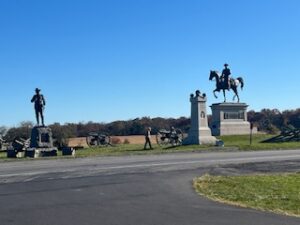
Just starting down the main entrance road – and seeing all those monuments – made me realize that I should get a tour to get some understanding of the overall site. All of the tours (to my knowledge) were arranged in town and not at the park entrance. And if I remember correctly there wasn’t one leaving soon.
There is an army of volunteer docents who, for $75 (up to 6 people) will give you a tour – but they required a 3 day notice. Nice to know when you get there.
The next best thing was for $15 – getting you a downloaded app and a GPS activated file that would give you an explanation at every stop. Isn’t technology wonderful? But make sure you have a charger or extra battery for your iPhone/Android – that uses power. This was available at the gift shop downtown.
I’ll say right off there are among you readers who know the battlefields far better than me. But I am inspired to get a copy of the excellent movie Gettysburg, which is based on the 50 year old best seller Killer Angels. I read the book, officially billed as fiction, years ago. But it is more than fiction. The author uses the various battles and fills in the conversations the commanders of both sides must have had during those battles. If not word for word, those conversations had to have been close to fact.
What were Lee’s words when J.E.B Stuart – his trusted calvary officer and eyes and ears – failed to report for more than a day? He was left figuratively blind on the battlefield with decisions to make. What were Meade’s words when, after the battle, he was urged to attack a retreating Lee? Author Michael Shaara “fills in the blanks”. Maybe I should reread it after all these years.
What were my impressions of the site? You can read all you want but until you see the various battle sites – for me it was like a wind suddenly overwhelming me. I knew that it was a desperate gamble by Lee to break through the Union lines, but until you see that field – where 12,000 brave soldiers marched on the open field while getting decimated by Union artillery fire. It was all just words and history until I saw that field and I would estimate it was at least 1,500-2,000 yards of open field to the tree line.
Or to go on Little Roundtop – where a former Maine college professor and now Union Colonel – , running out of ammunition, ordered his men to fix bayonets and charge down the hill.
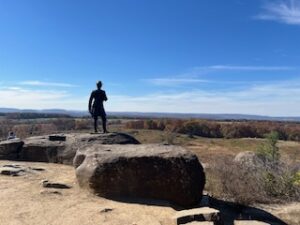
I didn’t realize that the Devil’s Den was a few 100 yards from that hill, across a creek, and filled with deadly Confederate sharpshooters nestled among the boulders. I was told that that creek ran red with blood during that time.
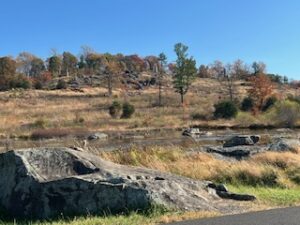
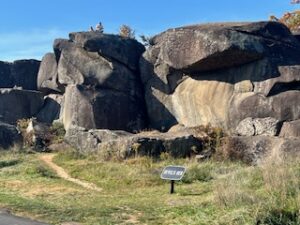
There was a sign at the top of Little Roundtop that stated that it looked different today – during the 1920s a virus ran through the area killing the prevalent trees. I forget what kind of trees were prevalent.
I learned that snipers, or sharpshooters as they were called then, were not an invention in WW1. Besides the Confederate sharpshooters just mentioned, I learned that there was a Union Colonel, Hiram Berdan, who taught a unit that could hit targets up to 600 yards – amazing to me considering those rifles.
What I remembered about my time at Gettysburg was the astounding casualties on both sides – it wasn’t unusual for a unit – Union or Confederate – to have lost half their men – killed, wounded or missing. There were over 51,000 casualties over the 3 day battle.
At the time of this writing, there is an excellent documentary on Gettysburg on Amazon Prime. It goes on a timeline – hour by hour, through each of the 3 days. And it is seen through the eyes of a number of Union and Confederate soldiers through their letters. And it presents a number of “what ifs” on both sides.
I had heard for many years that the Civil War was a war with the last of the old tactics and the beginning of new tactics. And Winston Churchill, who studied the American Civil War and knew of the ferocity and bravery that both sides fought, was relieved with our entry after Pearl Harbor.
Robert E. Lee lost a third of his Army at Gettysburg. It was the bloodiest battle ever fought on American soil. Gettysburg wasn’t Lee’s last chance to win, but it was his best. He’ll never come this close again.
—–Summary from the documentary Gettysburg
After Gettysburg, I was on a mission. “The wind” was taking me to Antietam, and it was just was just 46 miles away.
A Visit to Antietam

Following victories in the spring and summer of 1862, Robert E. Lee decided to carry the war north into Maryland, near the town of Sharpsburg.
In that short battle of about 12 hours on September 17, 1862, there would be an estimated 23,000 causalities, including 3,650 dead. To this day it was the bloodiest 1 day of causalities for America.
“Shells and Shot came whizzing into town shattering houses. The women and children still in town were running, crying, and screaming so loud that their voices could still be heard above the roaring battle and the bursting shells around us”
—Jacob Nathaniel Raymer
Private, Company C
4th North Carolina Infantry, 1862
“The slain lay in rows precisely as they had stood in their ranks a few moments before. It was never my fortune to witness a more dismal bloody, battlefield.”
—Joseph Hooker
Major General, 1st Corps
Army of the Potomac
As it would be nearly a year later at Gettysburg, the Antietam creek ran red with blood.
Despite the outcome being inconclusive, It did achieve several goals for the Union. Lincoln was terrified that France and Britain would intervene and want to broker “peace talks”, cementing the Confederacy, and talk of that stopped after Antietam. Also he wanted to issue his Emancipation Proclamation, but he couldn’t do this from a position of perceived weakness.
Over the years, it has been argued about the cause of the Civil War – was it slavery or a state’s right to leave the Union?
President Abraham Lincoln issued the Emancipation Proclamation on January 1, 1863, announcing, “that all persons held as slaves” within the rebellious areas “are, and henceforward shall be free.”
Initially, the Civil War between North and South was fought by the North to prevent the secession of the Southern states and preserve the Union. Even though sectional conflicts over slavery had been a major cause of the war, ending slavery was not a goal of the war.
That changed on September 22, 1862, when President Lincoln issued his Preliminary Emancipation Proclamation, which stated that enslaved people in those states or parts of states still in rebellion as of January 1, 1863, would be declared free. One hundred days later, with the rebellion unabated, President issued the Emancipation Proclamation declaring “that all persons held as slaves” within the rebellious areas “are, and henceforward shall be free.”
Lincoln’s bold step to change the goals of the war was a military measure and came just a few days after the Union’s victory in the Battle of Antietam. With this Proclamation he hoped to inspire all Black people, and enslaved people in the Confederacy in particular, to support the Union cause and to keep England and France from giving political recognition and military aid to the Confederacy.
Unlike my visit to Gettysburg, there were no electronic apps. I simply drove around the road, looking at the monuments and the buildings that played a part in the war. The NPS preserved the various buildings that played a part in the battle.
Wandering around the area, I found the home General McClellan used as a headquarters, and the adjacent barn used as a field hospital.
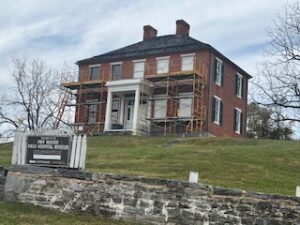
Amputations of the limbs was prevalent, because when that mini-ball from the rifle hit your bone, it obliterated at least 6” of the bone, which prevented any bone from healing. It took about 12 minutes to saw off a limb. Anesthesia was crude.
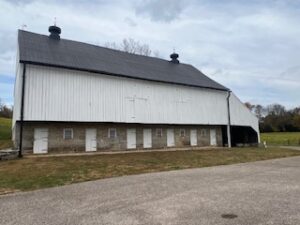
This is the battle where Clara Barton became famous. She would later create the American Red Cross, but here she gave aid to both Union and Confederate soldiers. Because the number of casualties was so horrendous and supplies were low, she would use corn husks as bandages.
What I learned here? 162 years later, it is still the bloodiest day in American history. In one day of battle, there was more than 22,000 casualties. A year later, bodies were still being found in the fields.
A Visit to Ft Sumter
Like Appomattox, Ft Sumter has been on my “bucket list” for years. The first shots were fired here in Charleston Harbor. Like Appomattox, my perceptions of what I thought it was vastly different from reality.
Charleston Harbor was a lot bigger than I imagined. The NPS has a dock – with a small museum – and a boat will take you to Ft Sumter. It took a good 30-45 minutes to reach it. I pictured it as it was, but during the War Union gunboats shelled it reducing it to near rubble. And what surprised me, between the Confederates shelling it from the mainland, and the Union gunboats, was the technology of the cannons at the time. They were not breech loaded (a shell loads from the back), but loaded from the muzzle (front). And they hit the fort from over 1,000 yards. They were very crude but effective.
The walls today have been recreated, and much shorter.

There is a great book I have been reading on Ft Sumter, and the beginnings of the Civil War. I have read many books by author Erik Larson, from subjects as diverse as the Galveston Hurricane (still the deadliest storm to hit the US, with at least 12,000 killed), to an American family whose father, a University of Chicago Professor, was picked by Roosevelt to be Ambassador to 1933 Germany (Roosevelt could not find anyone in the State Dept who wanted that position, imagine that!) , to The Lusitania.
He wrote about the Union Commander, Robert Anderson, who was a Kentuckian sympathetic to the South but loyal to the Union. He leads you step-by-step the events that led to the South Carolinians firing on Ft Sumter.
The book revealed some surprises to me. I had thought that the Union started to dissolve with states leaving when Lincoln was inaugurated. They started leaving under his predecessor, James Buchanan. By the time Lincoln assumed office, March 4, 1861, 7 state legislatures had already voted to leave the Union. When Lincoln asked for 75,000 volunteers to go to South Carolina to quell the rebellion, Virginia, Arkansas, North Carolina and Tennessee also left.
James Buchanan was weak, and his cabinet had divided sympathies. I think the book had quite a few revelations for me (for one the state legislatures were very divided over succession) and there was one agitator from Virginia who traveled the South for years urging them to succeed. Virginians ignored him for many years until the eve of the War. If I remember correctly the South Carolinians let him fire the first shot at Ft Sumter.
After Charleston I was off to Georgia to see a site my sister had recommended.
Andersonville Prison Camp
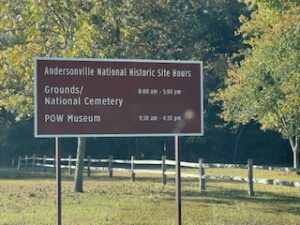
Andersonville was a Confederate POW camp in Georgia. It was notorious for the maltreatment of Union soldiers, with 13,000 dying of starvation and disease. Like Antietam, I just drove around and stopped at various sites. Like a visit I did 50 years ago while in the Army and walking up the Boulevard General Patton in Luxembourg City to see the American Cemetery and seeing 8,000 causalities from the Battle of the Bulge, 13,000 seemed just a number until you see the cemetery at Andersonville. And so many headstones read “Unknown” because soldiers did not have dog tags in those days. So many looked like the walking skeletons one saw when we liberated the Nazi death camps.
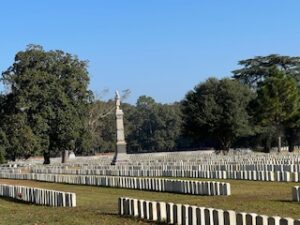
The actual site, like Dachau, is gone, but there was a small recreation of the walls (there were double walls). The source of water became polluted with human sewage, and there were no constructed huts for the prisoners, who lived out in the elements.
The camp commander, Henry Wirz, was convicted as a war criminal and hung in 1866.
While reading about the Army of Northern Virginia and the Army of the Potomac, I leaned an interesting thing about how they each handled enemy POWs. Neither had the facilities to house them so they reached an agreement. They had a system of repatriation until 1864, when the Confederacy refused to repatriate black Union soldiers with the rationale that they could be “runaway slaves”. Andersonville Camp was built in 1864.
Not that the Union side was guiltless, with many Confederate prisoners dying of disease. This was all before the Geneva Convention. But Andersonville stood above all the others for its death and suffering.
The Confederacy had 211,411 Union soldiers, with 30,218 dying in captivity. The Union had 463,864 Confederate POWs and 25,976 died in captivity.
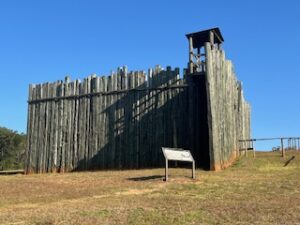
Something else I learned about the War – there are so many “Unknowns” on the headstones because none of the soldiers had dog tags. Some would sew their names into their Uniforms in the event they were killed, to at least let their families know.
Subsequent to my trip, I read that these conditions in POW camps of both sides was an understandable source of lingering bitterness for many years hindering the healing.
Vicksburg, Mississippi battle Site

One of the things I love about road trips is the unexpected things along the way. Unexpected things like memorable conversations with people and places. Part of the way my Garmin led me on Highway 80, and I stopped in a town in Alabama called Selma. While there, the lightbulb came on and I remembered the headlines from 1965.
Both at Vicksburg and Gettysburg, the NPS had some excellent documentaries explaining the battles. One of them was narrated by James Earl Jones. The Mississippi was always important, but in the 1800s it was the main highway connecting half the country. And Vicksburg was the last Confederate stronghold guarding the river.
It was the goal of Lincoln to split the Confederacy in two. Vicksburg was very well defended, with the Confederate side holding the “high ground”.
After a siege lasting more than 40 days, the Union side prevailed.
The Civil War was known as a war with new weapons that would be perfected in the future. When I was at Charleston, I was reminded of the Hunley, a Confederate submarine that sank a Union warship, and in the action, was sunk herself. It was the first successful combat submarine. It wasn’t found in Charleston Harbor until 1995, and now resides in a nearby museum (which was closed the day I was there). I got a chuckle hearing of their air quality test system – a lit candle. If the candle went out, they knew that they better surface! It was found in 1995 by the famous nautical explorer and author Clive Cussler, and the crew were later given funerals.
I had always thought that the Union Merrimack and the Confederate Monitor – and their battle at Hampton Roads, VA, were the first ironclad ships.
Apparently the City-Class gunboats, designed to cruise the Mississippi, came out about the same time. One of them, the USS Cairo, was sunk at Vicksburg and not discovered until 1956. The Cairo is on display by the NPS and at the time of my visit, was under some restoration with workers preserving the old wood.
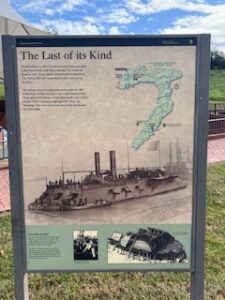
This reminded me of a visit I had 50 years ago in Stockholm, with the 16th Century Swedish warship Vasa, on its maiden voyage. It did not even make it out of Stockholm harbor, when it left the dock and 1,300 meters later tipped over and sank. It was top-heavy and remained under water for 333 years when it was refloated and I saw this wood preservative being sprayed on the wood in 1973 to strengthen it after being under water for centuries.
Anyway the Cairo looked to me like an iron clad riverboat, with cannons on each side.

My visit to the Vicksburg Park ended with a drive though the cemetery – and finding out the exit was closed. So I had to back up carefully though all the curves for ¼ mile. Strangest causality of Vicksburg – not buried in the military cemetery but the city cemetery.
After having late lunch at one of the 2 best local restaurants I found on this trek (reviewed at the end, under “odds and ends”), it was on to another goal I had – the WW2 Museum in New Orleans.
National WW2 Museum – New Orleans
Ever since this museum opened in 2000, it had been on my “to see” list. I didn’t realize that one of the 2 co-founders was the late author, Steven Ambrose. I was immediately taken by the size – occupying 3 large buildings. And I was surprised at the parking facilities – I could not find a dedicated garage. I did find a parking lot nearly across from the main entrance for $27 for 4-5 hours. A docent warned me that if my car was there a minute after the expiration it would have a boot on the wheel.
This was one of those museums for which one could spend 2-3 days wandering around. They had displays and rooms covering every major theater – Europe, Asia and the South Pacific. Many of the displays had listening stations with actual veterans who were there. It is an impressive facility and well worth a visit.
Most memorable display to me was the “Boeing Room” with what I called a “full scale boy’s bedroom”, with a B-17, C-47, P-51 among others hanging from the ceiling.
What makes a lot of museums extra-special are the number of docents scattered around the displays. That is what makes the Midway carrier so memorable in San Diego – a lot of Navy veterans who served at similar stations are there to tell you how things were. Her sister ship Hornet is at Alameda and you are left to wander around on your own for the most part. And there must have been a couple hundred docents scattered around this museum.
Upon leaving I complimented one of them on the excellent displays and lay out. He replied that it was “the best museum in the world”.
To which I replied “It depends on the subject”.
To which he insisted, “No, it is the best”.
To which I suggested just for thought the British Museum.
But there was no dissuading him.
I will say though that it is a world class museum dedicated to WW2. I think I can say it may very well be the best WW2 museum. At least our Congress thought so; designating it the country’s official WW2 Museum in 2004.
If you are on the road, here’s another couple of recommendations I have for museums of this subject. One in Kansas City, MO is dedicated to WW1, and I would say is also world-class. The other, located in Fredericksburg, TX, home to Admiral Chester Nimitz, is dedicated to the Pacific War. It is also world-class.
Odds and Ends
There were a few more stops I made that made “honorable mention”.
Claiborne Farm
Years ago – in the early 60s, during one of my summer visits to my aunt and uncle’s farm, my uncle drove the 160 miles to show me some of the Lexington Horse Country. This is where most of the champion thoroughbreds are raised. I can remember going to what is probably the granddaddy of these thoroughbred farms, Calumet Farms. We saw several horse breeding farms, but Calumet was the only one I remembered.
These days I was told they are not opened to the public, but Claiborne Farm gave tours. It was a simple hour “walk around” from the meeting point, but I learned a lot about the thoroughbred business. Even got to feed a $200 million horse. (He likes peppermint candy). He was retired and syndicated, and shares were either $1 million or $2 million. But none were available. A shareholder had the right to breed his mares once per year.
What stood out for me was the beauty of these animals. They are noticeably taller than your average horse. Don’t ask me how many “hands”.
- Curiosity got me. The hand is a non-SI unit of measurement of length standardized to 4 in (101.6 mm). It is used to measure the height of horses in many English-speaking countries, including Australia, Canada, Ireland, the United Kingdom, and the United States. I would guesstimate easily 2-3 hands larger than a normal (non-Arabian) horse.
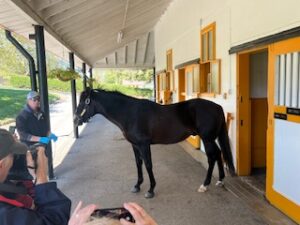
Maybe even 3-4. I had to wonder how the average jockey mounts these beautiful animals – with a step ladder?
I learned about the business of horse breeding. We were shown the room where they are brought. And no, their industry discourages selling the semen that a seller can use on whatever mare they choose. They want to control the bloodlines.
Finally, we were led to their horse graveyard, where many of their famous winners have their final resting place. One that I remember was Secretariat, a triple crown winner considered by many to be the greatest racehorse ever. I remember the headlines back in the 70s.
I read that Queen Elizabeth had a friend who owned one of these farms, and she would make unpublicized (off the radar) visits there. I asked the guide if that destination was here, and he replied in the negative although she had visited and was shown some of their champions.
I was glad that I made the decision to stop here.
Birthplace of Ulysses S Grant
On my previous loop of America, I wanted to stop and see my aunt. It would be the last time I would see her. I wanted to drive the route she took me when she picked me up from Cincinnati which was Rt 60. Although I was 12, I remember a beautiful drive down the Ohio River.
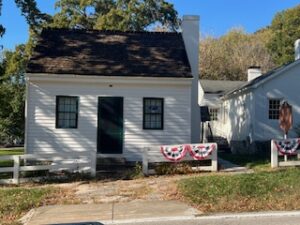
I had a few free hours in Huntington so thought I would drive back up 60. I came across the birthplace of Grant, at Pt Pleasant, a small town on the Ohio. It was a beautiful drive seeing a lot of things I had long forgotten. I didn’t get as far as Cincinnati, but realized most of the small towns I remember from 2006 are all about 30 miles down the river from there. I realized in 2006 there were a number of towns along the Ohio that were from our country’s earliest days.
Harpers Ferry Brewing
Yes! A Microbrewery! Dusk was coming, but I wanted to see Harpers Ferry, WV. And first, I experienced something that we in the west find hard to believe. On the road going into town, I crossed a state border. I can’t remember the sequence – maybe they are out of order, but I noticed a welcoming sign for Maryland. Then West Virginia. Then back to Virginia. All in about 10 minutes.
The traffic to Harpers Ferry was horrendous – stop and go for a few miles. I knew that I wasn’t going to arrive before dark, but a few miles out of town along the way I saw something that piqued my interest.
There on a bluff a few 100 feet above the Potomac River were a bunch of people looking like they were having fun.
So I made a U-Turn, drove back to Virginia and at the top of the hill there was a parking lot – full – and there had to be at least 1,000 cars there. I found literally the last open space, and at the brewery it looked like party central. There were 2 bars, one inside and one out, with at least 20 people in line at each. And at the top of the bluff where I saw the people was an open pit bonfire with people all sitting around laughing and having fun.
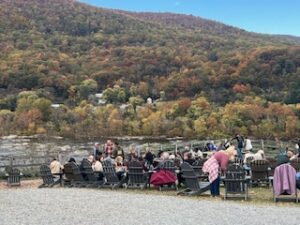
It was one of those unexpected things I have encountered in travel – unplanned – that turned out to be a memory. The Potomac up there was full of rapids – and Harpers Ferry was maybe a mile or 2 down the river and beautiful surrounded in the fall foliage. So I never got into Harpers Ferry – maybe next time – but still got a great memory.
Memorable local Restaurants
I have learned over time and travel how to know when you have discovered a good local restaurant – before even stepping foot in the establishment.
That bit of knowledge is seeing the parking lot full – and you have the only out-of-license plate.
I was driving down a main boulevard of Vicksburg, MS intending to see the old section. Mind you, during the siege most of the town was leveled and to escape the barrage the civilians were living in caves. So this was the “older” section of town.
Along the way, I saw a small – 2’ sign on the side – with an arrow pointing to the street having the Walnut Hills Restaurant. Of course, I had to see it and to my surprise, it was a nice house!
The tables were spread out among the various rooms with a cross section of Vicksburg’s citizenry. Everyone from businessmen/women to little old ladies were at the tables.
Of course, I had to try the plate with shrimp and rice – which was delicious – and for a side picked grits. I like grits and try getting them in California – even instant grits.
These were delicious with a thicker consistency than what I was used to having, and having Real Southern Grits. And as the witness in the Alabama Courtroom told Vinny, “No self-respecting Southerner would have instant grits!”.
I liked it so much I have their paper placemat tacked on my garage wall as part of my “art collection”!
When I visited a Houston friend, she took me to a local Texas favorite – the Taste of Texas. Again, my positive clue was a parking lot full of cars with Texas plates. I like Texas history – such a rich history – and normally they had walls full of Texas memorabilia but it was all Christmas decorations that time of year.
The servers were all young men – probably college students – in black suits and we were asked if we wanted to pick out our steaks. Do you want one with more fat or marbled? I let them surprise me and my side dish, brussels sprouts – with the garlic butter was even out of this world. I hadn’t had a steak this good in literally decades.
A Traveler’s Caveat
I’m driving in the middle of Texas on a Sunday evening and I get a text. Does my VISA card end in XXXX and did I just pay the state of California $560?
I know what you are thinking – I thought the same thing. All this garbage we get – some of it quite clever and unless you step back and take a breath – you can fall for it.
But they knew my last name and last 4 digits and I wasn’t going to give them any information they didn’t have. You know, “Please confirm your Social Security Number” kind of thing.
So I texted back – saying “No”.
I called my Credit Union Monday morning and they said that it was a charge to the California DMV. Which told me that the thief had a car newer and more expensive – market wise – than mine (I have 3 old Mercedes-Benz and each one is about $200/year).
So they cancelled my credit card.
In the middle of Texas with me about 2,000 miles away from home.
I did have a oil company card and thankfully they were in this area of the country but getting back – with a little less money in my checking acct (the only account I could access away from by Credit Union ATMs) – it would have made for a great reality show.
Toss the player a few $100 2,000 miles from home and see who gets back – or if they get back.
I stayed at places I wouldn’t have normally stayed and ordered meals a bit downscale (would have loved a steak at a famous stop we have on I-5, but the Shepard’s pie was also delicious!).
The lesson here is to carry 2 credit cards. How they got my card info I don’t know – the card never left my possession. Either they hacked some company’s computers or – equally likely – copied the info at a restaurant when I gave the card for payment.
Someone I talked to since the episode knew of a restaurant who had an employee who would copy all the cc info before returning the card to the customer – he was of course fired. But maybe paying in cash at restaurants unless they have a hand-held POS device or one is at the table is the only way to pay at restaurants.
SiriusXM Trivia I learned Driving At Night
ABBA’s breakthrough song
It was interesting at least to me. While listening to host Neil Sedaka on the 50s Channel, he then played the 70s hit from ABBA, Ring, Ring. Sedaka is both a successful songwriter and singer who had a lot of hits in the 50s and 60s. And I thought, “What’s up with this? Surely, he knows that this is from the 70s!”
Well, he told the story after the song. ABBA originally sung in Swedish. They asked him to write the lyrics to this song in English. They then won the Eurovision contest and the rest is history. I don’t believe they really achieved the supergroup status in the US that they did in the rest of the world (I think they were even bigger than the Beatles!), but how many ever heard an ABBA song in Swedish? I don’t know if Sedaka ever wrote more of their lyrics but this put them on the road to superstardom.
I always thought it was a bit funny that I could understand every word of this Swedish group, but British and American singers sounded like they had “mush in their mouths”.
The Rock Group the Beach Boys Hated
And it really had nothing to do with the group or the song, but who was behind them. On the 60s channel, the host was telling us a story that Beach Boy Mike Love told him. They hated this group, because the man behind them was the father of Dennis, Carl, and Brian Wilson. He was very abusive and although he was their father, they finally fired him. So as a way to get some revenge, he managed this group, who had one hit. Brian eventually became such a successful song writer that he was (is) admired by Paul McCartney, and the admiration is mutual.
Magic in West Texas
On I-10 with a sunset and rays poking through the clouds, I was listening on Willie’s Roadhouse to Willie sing My Heroes Have Always Been Cowboys. It was one of those magical moments.
Learning About the Grand Ole’ Opry
At night coming into Vicksburg and again on Willie’s Roadhouse, they were playing a program hosted by the Grand Ole Opry from Nashville. I have liked Country music from the 80s and 90s, but the new artists they profile on stage really had a connection with the audience. And listening to them talk about their backgrounds, and what motivated them to write and play the songs they were about to sing, really moved me.
By the way, there is only one band for all of the artists on stage – from the Grand Ole Opry. They have one practice session with the artist, and then they are on stage. And they sound like studio musicians just for each individual artist. Talk about knowing your business and perfection!
Check out Mae Estes!
Didja know that the Grand Ole Opry has the oldest radio program in the US (if not the world?) Next year will be their 100th anniversary.
A Couple of Short but Memorable Conversations
At an Applebee’s restaurant in Kansas the family next to me was in the oil business. For those who aren’t aware there must be 50 – or more – ways you can be in that business – from exploration to extraction to transportation to…
Anyway the husband was telling me about the opposition to the Keystone Pipeline when there are already many oil lines in the country. According to him, it was the railroad interests who wanted it transported by rail car instead of the pipeline.
At one of my favorite hotels in Gallup, NM
An attractive and well-dressed older woman is also checking out and (presumably) her daughter – also attractive – is trying to push out an over-loaded cart with 15-20 pieces of luggage. I hold the door for them and naturally have to quip that “You like to travel light, I can see!” I can’t help it.
Which got a laugh and it turns out they were visiting from Britain. They had just come from New Orleans. So I had to ask the mother if they had seen the WW2 Museum.
“No”, she answered, “When we are traveling, we just get a little taste of this, and a little taste of that…”
Which I completely understood. We all have deadlines and want to see certain things – what do you see and what do you forego?
I passed the entrance to Ft Bragg (it may be forever Bragg before I start calling it Ft Moore although the new recipient is certainly worthy). And virtually across the street were 2 museums – one dedicated to the infantry and one to the Civil War Navies. I started to turn left then realized that was another day. I had to decide that taking a week or more to drive up to Halifax and seeing the Nova Scotia coast would have taken too much time from the rest of the things I wanted to see.
So to some degree or another we all “take a little taste of this and a little taste of that”.
I’ve already been through Montana and the Dakotas – Butte to me is fascinating with the history. And Bismarck has the most interesting state capitol – being art deco.
Maybe Canada?
Maybe next year, God willing and if the Dog Catcher doesn’t catch me, I’ll hit the Henry Ford Museum, upper Michigan Peninsula, Niagara Falls, Nova Scotia and New England. Maybe cross the Trans Canada Highway? I’d like to see Montreal, too.
Cross Posted at the Lexicans
I had the pleasure of taking a Civil War and Reconstruction course from James McPherson (who was the academic historian along with Shelby Foote in Ken Burns’ Civil War) in the early 80s. “Killer Angels” was on the reading list.
For the museum section, I have been to both the WWI museum in KC and the Pacific War museum in Texas. Both were very good.
I spend a lot of time in Maryland and much as with home in Arizona and the Grand Canyon, I try to spend a lot of that time seeing the local sites. For Gettysburg, that usually means 3 to 4x a year and sometimes more given that’s just as few miles off the Hwy 15. Many a time traveling from back up north we’ve passed by exit sign to the town and to the consternation of the missus I swerve off because I just a had spark of insight about how a unit used a piece of terrain in the battle. If you are in the upper South, visiting Civil War battlefields is the male equivalent of antiquing
I saw the movie “Gettysburg: before visiting the site. What always amazes about cinematography is the use of shots to maintain authenticity and enhance perception; after seeing all the monuments and unit markers across the battlefield I went back and watched the movie and was amazed none made it in
My first impression of the battlefield as a westerner? “You’re calling that speed bump of Cemetery Ridge a ridge?” However you do get a different tactical perspective of the ridge when you walk the steps of Pickett’s Charge but still.
When you drive in the general area of the Shenandoah, Hagerstown, and Gettysburg you get a good understanding of the terrain and why Antietam and Gettysburg (as well as Monocacy Crossing) was fought where and how it was. Look at a topographical map or barring that simply trace I-81, I-70, and US 30 – that will teach you all about operational maneuvering of the Confederate 1862, 63, and 64 campaigns in the north
A good guide to Gettysburg, not just on the battle, but also formations, tactics, weapons etc… is Mark Adkins’s ”The Gettysburg Companion”
15-20 pieces of luggage in Gallup? Took me a bit by surprise, but then you did mention they were from Britain and the town does market itself as the gateway to Navajoland and it’s the biggest town between Flagstaff and Albuquerque; I usually just stop to either see the bishop (my old pastor) or for Lottaburger
You do need to go to Montreal and French Canada in general, as a general rule of thumb any place in the world that has ummm “brisk” winters you should go visit in the summer because they know how to throw a party. My favorite time of year is early July for Jazz Fest. I would also venture further east into Quebec where it is less anglicized and you still have the spirit of Les Habitants, the old French Canada. I wouldn’t let a lack of French stop you, as long as you can read it, speak a little and they know you’re an American you’ll get by. I’ve stopped in many a hole in the wall town in southern and eastern Quebec got a suspicious look until I told them where I was from and then a long conversation would ensue with their inevitable question along the lines of “I have a friend who spends the winter in Phoenix, Pierre do you know him?”
Back when you could get a driving docent at Gettysburg within a few minutes of arriving there, we hired one for a two hour tour. He was quite good–and he deprecated Killer Angels, claiming it relied too heavily on Longstreet. He suggested High Tide at Gettysburg instead.
I second your recommendations of the National WW2 museum, WW1 museum, and the Pacific war museum — we saw those on our (shorter) tour early this year.
General Grant’s military secretary at the time of Appomattox was Ely Parker, a Seneca Indian whose tribal name was originally Hasanoanda, then Donehogawa (not sure why the change)
He became an engineer. Seeing him at the surrender, General Lee extended his hand and said, ‘I am glad to see one real American here.’ Parker shook his hand and said, “We are all real Americans, General.”
Perfect thing to say under the circumstances.
There’s a good video about Parker, “A Warrior in Two Worlds,” which gives some idea of the challenges he faced in bridging two very different cultures.
When I was 7, my family visited the Gettysburg battle site. There is a photo of me lying on the ground, “wounded.” Or was I “dead?” Other than the photo, I remember nothing of the visit to Gettysburg. I doubt we got a tour guide.
My brother and family lived in the DC suburbs for 25 years. In my visits there, we never made a trip to Harper’s Ferry, although we have a family member (first cousin of a great-great grandmother) who was a member of John Brown’s crew, and died at Harper’s Ferry.
Fortunately, my grandmothers handed down some family stories about the Civil War. One written in a family history, the other tape recorded when she was 86 years old Confederate and Union stories.
That oil man wasn’t blowing smoke. There are ~300,000 miles of gas transmission lines and ~228,000 miles of oil transmission lines. What environmentalist has been complaining about them? Which means that adding another thousand or two thousand miles of oil transmission lines is not the environmental disaster that some claim.
Warren Buffett owns Burlington Northern. Do the math.
Some oil is being shipped via rail to US refineries (plus the already-existing Keystone pipelines), but there are also proposed Canadian pipelines to take carry oil to the Canadian East Coast and to Montreal. Also possibly some connections to the West Coast ports for export.
In the documentary on Gettysburg on Amazon Prime. there was an instance that summarized the whole sadness of he Civil War. Maryland was, like Kentucky, split as to the loyalties. The eastern side was pro-slavery. During the Battle a Confederate from a Maryland unit met a union man from a Union Maryland Unit.
@Mike – The El Rancho for 40 years – from the 20s-60s – was a rest stop for movie production companies making movies primarily in Monument Valley. Being on Navaho land, they would live in Tents there and then after awhile travel the 180 miles or so south to the the El Rancho. If you go upstairs, around the perimeter there are a couple hundred B & W photos signed by everyone from Lee Marvin to Douglas Fairbanks to Lee Remick.
I think that his hilarious, the visiting of Civil War Battlefields being the male version of “antique shopping”!
@David – what a wonderful response and just as appropriate today